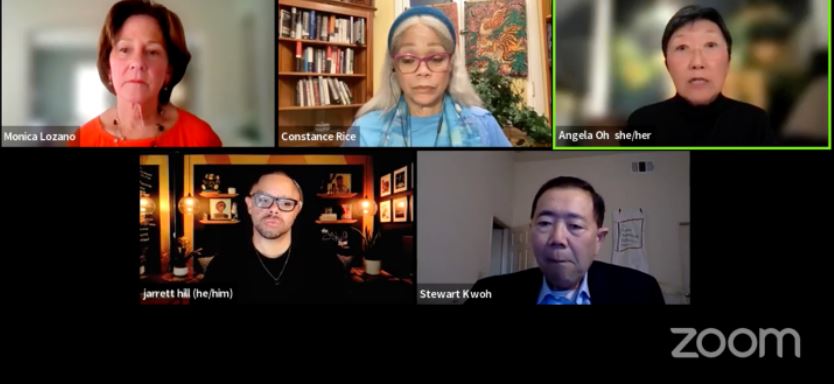By Erin Chew, AsAmNews Staff Writer
April 29, 2022 marks the 30th anniversary of the LA Uprising and the role Asian American and Black leaders, advocates and ethnic media had in changing the racially divisive narrative. In five days of unrest ignited by the acquittal of four police officers in the beating of Rodney King, rioters caused an estimated $1 billion of damage and more than 60 people lost their lives in an event the mainstream media labeled as race-related violence.
What role did the actions of police and government play in this? Has the mainstream media learned lessons from mistakes made in its coverage? Where to from here and into the future?
These questions and more were addressed and discussed at a virtual panel titled LA Uprising/Saigu Reflection organized by Asian Americans Advancing Justice Los Angeles (AAJA-LA). Connie Chung Joe (CEO, AAAJ- LA) hosted the virtual panel and Monica Lozano (President, College Futures Foundation/CEO La Opinion) moderated.
The virtual panel included Civil Rights leader Connie Rice, Attorney Mediator Angela Oh and founder of AAAJ – LA Stewart Kwoh, all who were present during the LA Uprising of 1992 and worked together with other community leaders to try and calm tensions as well as call out the dominant media in how they reported on the situation. USC Professor/President of the National Association of Black Journalists, Jarrett Hill, provided observations and reflections on the state of race relations in LA and in the US.
Chung Joe grew up seeing the divisions between Black and Asian communities and the images the dominant media put out to sensationalize the “race wars”.
“The result was the perfect example of the model minority myth and a criminal justice system that put a Korean immigrant’s life on top of a teenage girl who was Black,” she expressed. “The dominant media framing of the Korean versus Black communities pitted these two communities against one another. Blacks were seen as turning down buildings and looting stores, and Koreans were vigilantes on store rooftops with guns shooting down on the street.”
Lozano emphasized the importance of remembering what happened in March 1992.
“The video of the brutal beating of Black man Rodney King by the LA police was taken on a handheld camera by a local resident and taken to KTLA – a local TV station who aired it before it was distributed nationally”, Lozano said. “This video began our modern-day conversations on race relations in LA that became part of the national discourse for well over a year”.
For the African American community, the 1992 LA Uprising left a deep wound, one which embodied racial, economic, and political injustice.
“For the working class and poor African Americans, they had seen 80,000 jobs leave the South Central area,” said Rice. “When your entire economic base leaves, you are going to have a gap there and people fall through the cracks, and then you have an emerging and gang culture and of course, the dominant media covered most Blacks in LA as criminals and as being violent because that was what the elite communities feared”, she expressed.
For the Korean American community, “SAIGU,” which means 4.29, commemorates the day the Uprising began. $400 million of the property damages occurred to Korean-owned businesses, many in Koreatown.
“When I think about the impact and the trauma that was placed upon small immigrant Korean store owners in LA, I can say that for Korean immigrants everywhere across the US at the time were shaken by what they saw”, Oh said. “There were deep wounds and confusion and it was important that we engage and work together as Korean, Asian and Black communities, to show the real story and reasons of how 1992 happened.”
A coalition of Black and Asian leaders, including Kwoh, met with the editors of the LA Times to confront them on the newspaper’s reporting.
“We went to the LA Times and said a small percentage of Korean Americans were trying to protect their businesses with guns, but that was the only image shown by the LA Times. It was inaccurate, imbalanced and it took everything out of context on the injustices faced by both communities – whether Korean American or African American”, Kwoh stated.
Hill provided some observations on the dominant media coverage of race and how representation in the media starts at the top with leadership and decision-makers.
“I think one of the things we have to do first is to recognize that the dominant media’s role was and has never been about upholding a multi-racial democracy. Upholding a diverse democracy or even supporting and encouraging a diverse culture and society has never really been a priority of the media right?”, Hill rhetorically questioned. “We are trying to change the system and bend it to the needs of what we need for it to reflect, so this is why we need to diversify our newsrooms and not just for interns or news reporters but also for editors, directors and the owners of these media companies”.
This virtual panel was held weeks ahead of AAAJ-LA’s upcoming event on April 29 – “30 Years Later: LA Uprising Saigu Peace Gathering”, which is an in-person event held to honor and remember the LA Civil Unrest of 1992. For more details and to register, please click here to access the event link.
AsAmNews has Asian America in its heart. We’re an all-volunteer effort of dedicated staff and interns. Check out our new Instagram account. Go to our Twitter feed and Facebook page for more content. Please consider interning, joining our staff, or submitting a story, or making a contribution.




